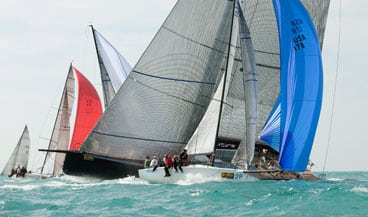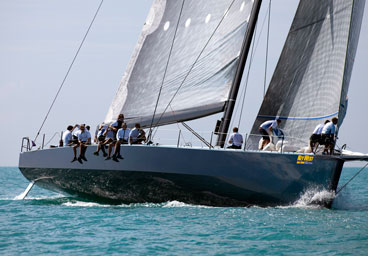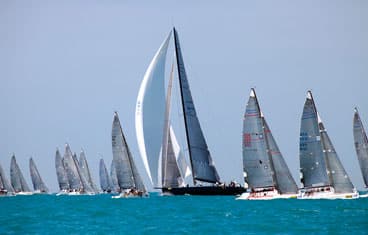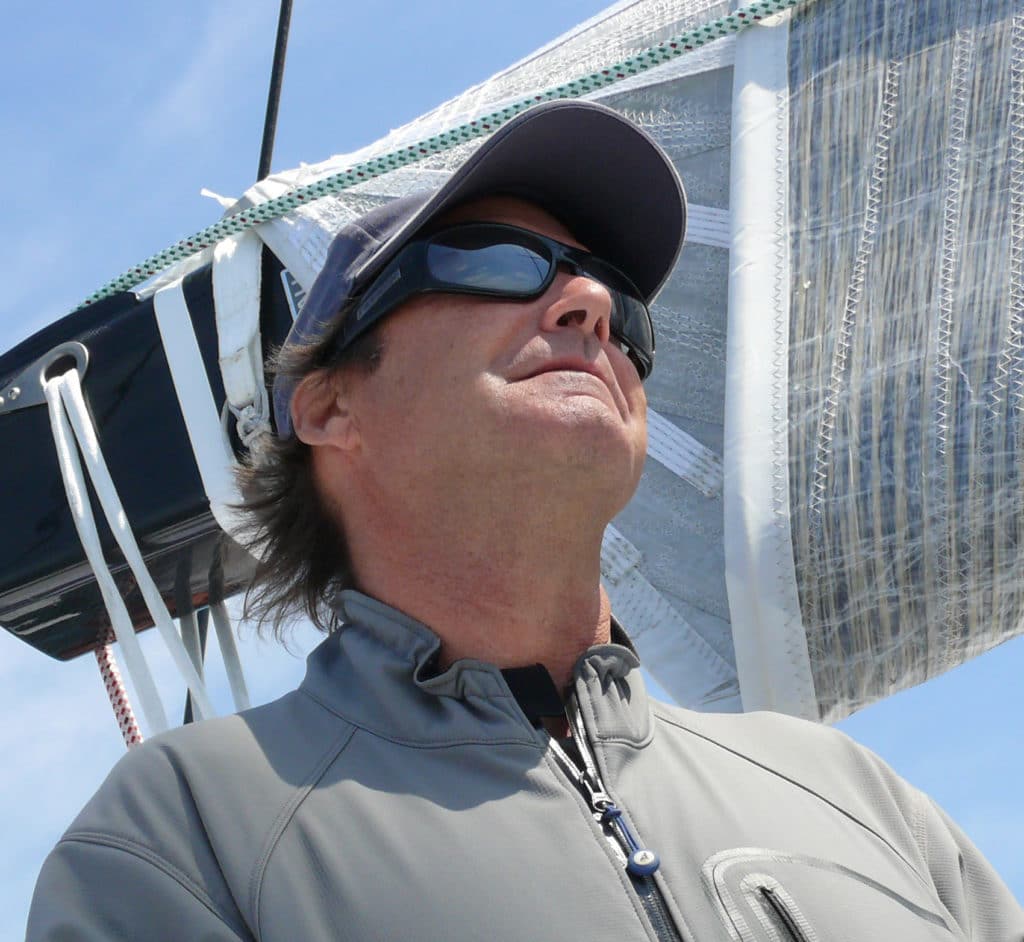For access to all of Sailing World’s coverage of Key West 2010 Presented by Nautica, please click here.
For the KW 2010 homepage, click here
Friday, January 22
What’s It Take to Douse Fling’s Big Kite?
I’m on a plane now, winging back to San Diego after eight days in Key West. I’ve been coming to Key West for regattas since I was in college and love the island for its lush natural beauty, the funky town and its history, the banyan trees and wild chickens and the great warm water sailing conditions.
Today’s races went just about perfectly for us on the Highland Fling. We won the day in our class with a 1-2 and made a move up the series scoreboard from third to second, passing the well-sailed TP52 Interlodge.
Our bullet was partly thanks to some bad luck for the series victor in our class, the Reichel/Pugh 69 Bella Mente, who pushed their trademark pin end start a little too close in the first race and got their 15-foot deep keel fin snagged on the anchor line of the pin-end starting boat. Meanwhile we pushed farther down the line than usual because of the big pin-end bias and hit the line doing 13 knots just to windward of Bella Mente, so we got a good view of their plight, which took more than 5 minutes to get sorted out. By the time they did, the fleet was gone and the race committee had to throw up the AP and wait for Bella Mente to give them back their starting line before rolling into the sequence for the remaining three classes.
The southerly winds had a lot of gradient shear today, so atop Highland Fling’s 130-foot mast we were seeing 2 knots more than the 8- to 10-knots that the TP52s were reading, making it definitely a “big-boat” day for the final two races.
Our first race bullet gave us back the tiebreaker over Interlodge, but we still were a point behind. But given the wind conditions, I was pretty confident we could sail a conservative race and still beat Interlodge, which was all we had to do to move up to a series second.
To make matters better, Interlodge got the short end of the tussle between the four TP52s at the committee boat end of the second start and we got off the line smoothly just to leeward of that jam up and were able to sail our race.
The only hitch was at the leeward gate, where after pushing the string takedown pretty darn tight, we turned up around the left hand buoy and with the sails flapping and the call, “no winches!”
Remember, Highland Fling has powered winches that are controlled by push buttons next to the winch. But for the second time during race week, the engine stalled after a takedown (maybe we loaded things up too much at the takedown) and the engine had to be restarted before we had any winch power.
Irvine Laidlaw luffed the boat so the sails could be trimmed in by hand, like a Laser, while the crew scrambled for the back up winch power – winch handles…. Which look pretty puny when inserted into Highland Fling’s giant winch drums. About 30 seconds later the power was back on and the push buttons could do their job. By then we had given up too much time to have any chance of beating Bella Mente in the race, but we still had a nice cushion on the
52’s.
One of the biggest steps forward this week by our team was the development and refinement of our string takedown system. Designed by Dave Tank, this system allowed us to keep the spinnaker up to about three boatlengths from the bottom gate. But getting a string system to work on a boat as big as Highland Fling is no easy feat, and requires great teamwork and timing amongst the whole crew.
With fourteen leeward mark roundings, Key West Race Week gave us a chance to really hone that system and our timing. It starts with the approach to the mark. We try to have at least a minute and a half on the final jibe to get the jib hoisted and the crew in position for the takedown. One problem is that the gates at KW are quite close together, so you need to pick a good layline to the windward buoy (on your final jibe), and if you are overstood, you have to come in heated. Either way, it requires crouching on the leeward deck to peer under the foot of the spinnaker to determine when you can start the all-critical “swabble.”
The swabble, the turn down, is crucial to the string takedown as it unloads the spinnaker and brings the boat more upright so the spinnaker (which is being pulled in super fast by a powered winch winding the “string line” attached to patches in the middle of the spinnaker) can more easily drop in over the lifelines and into the bow hatch.
Interestingly, on an AC boat, where string takedowns were first employed on keelboats (they’ve been around in dinghies for decades), you don’t have to swabble as deep because there are no lifelines to impede the spinnaker getting sucked into the hatch.
If it goes well, the spinnaker doesn’t get torn, the string line doesn’t break, and the rollers on the forward hatch survive to live another day.
On top of that the spinnaker, now in the bilge of the foc’sl, is prepped well for a “quick pack” (our packing team of five people on Highland Fling could band (with yarn) the head and the tack of the dropped kite and have it untwisted and ready for hoisting in under eight minutes. Believe me, they were working as hard down below on the second windward leg as any crew on any boat in Key West.
As a final note, during practice we decided not to re-bag the dropped spinnaker but rather just band it and keep it hooked up under the main hatch (like an AC boat or a Farr 40). It was easier to hoist out of the hatch than bringing the bag to the rail per the old style of spinnaker set on bigger keelboats.
So all in all, the Highland Fling team had a very successful week. We achieved our primary goal of learning how to sail the boat, and successfully developed systems so we could sail it like a much smaller boat. Next up for the 82-foot Wally, the trade winds of St. Maarten in early March.
Thursday, January 21
Speeding Through the Minefield
Well, racing in Key West doesn’t get much better than today. Aboard Highland Fling we had our best day, posting a 3-2 on handicap, and thanks to increased windspeeds, we simply flew around the course. Top boatspeed for the day was 20.2 knots (in about 18 knots of wind speed) and owner/helmsman Irvine Laidlaw was all smiles.

JH Peterson| |Highland Fling charges through the Melges 32 fleet.| The other classes on the course must’ve been getting dizzy watching us, as we’d quickly lap them on the track, even though they were sailing to a shorter windward mark. Part of the tactics involved in sailing a boat that is so distinctly faster than the other fleets is to ensure we don’t come into a bunch of boats in a position of weakness (i.e., taking the spinnaker down on port tack). The race committee has done a good job tweaking start times and course lengths to avoid confrontations, but it’s hard, and today we flew through the Melges 32 fleet a couple of times right during their mark roundings.
Although we still could not keep up to the pace of class leader Belle Mente, our crew was happy to have an error-free day in the boathandling department. We were looking forward to the challenge. After three days of refining our boat handling techniques (remember Highland Fling is essentially a brand new boat) in the light and moderate airs the 18 knots that greeted us for Race 1 gave us a good test and we passed with flying colors.
Not only were the giant spinnakers getting packed in under 10 minutes, but we were pushing our string takedowns right to the bottom mark. It certainly feels good to be making progress in learning how to sail this huge boat like a small boat (which is what you have to do if you want to perform well on the ultra short race track here in Key West).
It was a beautiful day too, sunny, temperature pushing 80 degrees with the southerly winds and to top it off, there were plenty of dolphins jumping around us to make us appreciate the natural beauty of this great part of the world. The wind was steadier than previous days, so on the big boat, which costs so much to take, we stretched things out and minimized the maneuvers. In the first race, we were going so fast that we kept our jib up on the downwind legs.
One more day of racing and we are still sitting in third place in class, 3 points behind the TP52 Interlodge. Two races are scheduled tomorrow, so we still have a shot at closing the gap. Meanwhile Bella Mente has things just about sealed for victory but with no throw outs they probably still have to go out and sail at least one race.
Wednesday, January 20
Now It’s About the Points
A beautiful day today off Key West. With the wind doing its classic south Florida clockwise rotation, we had light east winds in the morning, rather than the northerly winds of the previous days, which picks up the rather cold water temperatures to the north in the Gulf of Mexico.
Aboard Highland Fling we had a fun day, and had our moments, but in the end, the scorecard shows a 3-4 for the day and we dropped one more point farther behind the TP52, Interlodge which lies in second in the series standing.

Richard Langdon/Ocean Images| |Highland Fling turns another corner off Key West.|
Key West Race Week. Great venue, even better racing. Bella Mente finally showed that she is beatable, taking a third place in the second race after continuing her string of bullets in the first race.
We started on time again at 1035 in a light easterly breeze that was very very unstable. Unlike yesterday, where the breeze could be played by employing tactics for oscillating windshifts. Today one had to keep their eyes open for big fields of varying wind pressure.
In this first race, there were times where the windspeed measured 130 feet above the water by our instruments was just 5 knots, so it paid to try to stay in the breeze, yet still respect the big windshifts on the course. It wasn’t a total one-sided race track though, as we determined by watching Farr 40 and Melges 32 classes carefully to see what’s “working” for them. We have a great view of the action because of Highland Fling’s generous freeboard, which is augmented when the boat heels. If I stand up, I’m probably over 12 feet above the water. That gives a lot better view than on a Melges 32!
Principal Race Officer Ken Legler was patient in launching the second flight as the wind was quite light between races, but when the 9 knot (at our masthead) easterly pushed back in he quickly got things rolling for the second race of the day. That’s one of the things sailors have come to take for granted at Key West Race Week – races run by a top notch race committee that makes well informed decisions.
So we are now past the halfway point in the event and one would characterize it as a light-air, smooth water series so far. But that could change tomorrow morning as the clocking wind will be out of the south (making for bigger seas) and we will likely see over 15 knots for the first time this week in Race 1.
Last night I enjoyed the Storm Trysail Club dinner, and tonight it sounds like the ticket in demand is the Melges party. Plus one can always take a walk down Duval street to do some people watching or even visit the Chicken Store (Key West’s wild chickens really add to this places Caribbean flavor).
The Highland Fling crew will of course head to bed early all focused on trying to close the four point gap between us and Interlodge for second place in the series standings.
Tuesday, January 19
Making Strides with the Fling
Well, after five days here in Key West we are starting to hit our stride for the regatta. Because the racing starts relatively early (1035 first start), the morning schedule is always a bit tight, especially if one stays out late, as has been known to happen when lots of sailors gather in a tropical place for a while. Last night I snuck out to the Hog’s Breath Saloon to see my friend Deblois and her great San Diego-based band play in the first of their week-long run here in town. They played a bunch of songs off the new CD (you can check it out at www.debloismusic.com)
We left the dock this morning with expectations of a lighter wind day than yesterday, but fortunately the forces of mother nature gathered up some steam and we had great 9- to 11-knot winds with some tricky shifts to play with on our 2-mile windward leeward race track.
When I filed my story yesterday I reported that we had two-second place finishes, but it turned out we scored a fourth in yesterday’s second race, because the race took 20 minutes longer than I had allowed for. Ah, the joys of racing handicap.
Today we think we scored a 4 and a 3 in the two races, which again saw us finished up before 2 p.m. A lot of the racing today on our course was dictated by the windshifts. Key West is really fun to race in when the wind comes from the Northeast, as it did today, because there are some great oscillations and bands of pressure to play with.
Of course, on an 82-foot boat with powered winches you don’t want to be doing a lot of tacks and jibes, but the shifts were big enough that you had to respect them on the windward legs, when they come through faster than when we are on the downwind legs.
Once again the 69-foot Bella Mente sailed superbly in our class and probably posted two more bullets to keep her score card for the event pristine. We are starting to realize that it’s going to be tough for us to beat the smaller boats unless we really get some breaks we simply give away too much every time we make a maneuver. Even though our crack crew has learned how to sail Highland Fling pretty darn good in the last few days we still give up distance at every turn.
Let me give you an example. We have to take down the spinnaker a boatlength or two farther from the mark than our competitors … probably because there is more sail to get aboard. We are making gains though. We started the regatta beginning the takedown six boatlengths from the turn and now we are down to two boatlengths.
So nearing the regatta’s halfway point we believe we are about 3 points out of second place behind the TP52 Interlodge, one of four TP52s in the regatta. Bella Mente is well launched with those four bullets. Still a lot of racing to go and we expect a bit more wind tomorrow, so who knows what will shake down next.
Monday, January 18
Pin-Ping Pileup
The first race day for Key West Race Week presented by Nautica kicked off with weather conditions significantly different than our previous three days of practice. Where the practice days featured fairly windy conditions (on Highland Fling we hit 27 knots of boat speed on Friday), the wind was soft and out of the Northeast.

Richard Langdon/Ocean Images| |Irving Laidlaw’s Reichel/Pugh 72 Highland Fling threads through the Melges 32 fleet at Acura Key West Race presented by Nautica. | We had a good first day, finishing with two second places on corrected time to the very well sailed Reichel/Pugh 69, Bellamente, which picked up two bullets. This was Highland Fling’s first time racing on a windward-leeward course and we are still learning how to sail this very big and powerful boat.
In the first race we left quite a bit of time on the course on the final run when we had some jibing problems that arguably cost us the race. In the second race, Bellamente sailed beautifully, and we could not save our time on her. We owe her almost 4 minutes in a one-hour race and we owe the three TP52s about 12 minutes in that same time.
Our class (IRC 1) shares the Division 1 course with four other fleets, including the Farr 40’s, Melges 32 and IRC 2. This creates some interesting challenges at times-even when we are not racing. For example, the pin end (a power boat) didn’t get settled in its final position until about five and a half minutes before the start, which led to a big jam up at the pin end of the line while all the boats sailed past to get their “pings” for their computer starting line software.
Despite sailing instructions that ask boats not starting to stay well clear, and hails by the race committee on the radio, the jam-up was so massive we gave up trying to get our ping. It’s pretty nerve wracking threading your way through a group of boats randomly reaching around a rather short starting line in a boat twice the size as most everyone else. But its great having the two of the premier one-design classes on our course, as they provide excellent feedback on what strategies are working on the course, and the racing is so close its fun to watch.
We had about 11 knots of wind in the first race and it eased a bit during the day. Nice warm “t-shirt and shorts” weather for the whole day (at least on a boat with a five foot freeboard)! The racing went off on schedule (1035 start) so we were all finished up before 2PM and plenty of time to enjoy shoreside Key West. I’m looking forward to seeing some musician friends tonight at a local watering hole (The Hog’s Breath). Deblois and her San Diego based bandmates just came out with a new CD and will be playing there all week!
-Peter Isler
Friday, January 15
There’s Not A Whole Lotta Runway for the Fling
Heading down to Key West brings back many great memories. The venue, both on the water and shoreside is one of the best there is. And I have plenty of sea stories from that tiny island that are still fresh years later. Like the time when we were training before a J/24 midwinter regatta and picked up a guy swimming well offshore. His name was “Will” and his intended destination was Cuba – until we “rescued” him. Or the time Jimmy Buffet walked by our boat (the IOR 50 Locura) and asked me for help putting a crew together so he could enter his boat (a classic woodie). The wives and girlfriends from our crew were eager to oblige.

Sailing World/Dave Reed| |SW Racing Editor Peter Isler will be calling the shots on the Wally 82 Highland Fling XI, Key West Race Week’s biggest entry. His biggest challenges: depth, and rapid maneuvers.| But I digress, as is easy to do in Key West. This year my focus is the new Wally 82, Highland Fling XI, a powerful Reichel/Pugh designed sloop aboard where I’ll be calling the tactics. Highland Fling is a beautiful big boat, with teak decks, push button winches, and a carbon rig taller than an AC boat’s. It is probably also the deepest-draft boat ever to enter Race Week. With a draft of 17 feet, and target speeds over 20 knots in big breeze, there is precious little playing field for us between the outer reef and the inner banks lining the big-boat race course. We sailed the previous Highland Fling (another Wally with about a meter less draft) in KW two years ago and were somewhat constrained by depth issues in many of the races. This year, that problem will be greatly exacerbated by both the new boat’s deeper draft and its much higher speed potential. Suffice to say, I’ll make sure navigator, Matt Wachowicz, is always close by.
So I’ve been stressing about avoiding putting high speed divots into the seabed with our keel bulb for the past few days. But paranoia will destroy you, so it’s time to shift to something practical, like winning races. Key West is Highland Fling’s third race and first time around the buoys. Owner and helmsman Irvine Laidlaw has plotted a full schedule for the boat this year, in the Caribbean and then in Europe. Key West provides an ideal opportunity to quickly get the boat and the crew up to speed on tight windward-leeward courses. I’m thinking of KW a bit like spring training, with lots of repetitions to get our chops down. On the racecourse, Highland Fling will be a bit of a fish out of water, (hopefully not literally), with no other similar sized competition. To win races here we’ll have to beat the TP52s in our class by about 20-percent of our elapsed time-12 minutes for every hour on the track.
Having sailed maxi’s a fair bit over the past year, I’ve seen first hand the advantage the smaller boats have at the corners of a short, windward-leeward course. The smaller boats are simply easier to sail crisply, spinnakers go up and down faster and the boat gets ripping faster out of tacks and jibes. Key West races feature multiple laps and relatively short legs (in 15 knots of windspeed, Highland Fling will sail a 2-mile downwind leg in less than 10 minutes!). Plus, there will be times where shallow water will restrict our ability to play the shifts. It won’t be easy, but we’ve got a great team on board and our challenge will be to hone our skills at the corners in our three days of practice so we leave as little on the table as possible at the marks during the races. So boathandling will be our primary focus during the practice days (hopefully we don’t get blown out, because we need all the practice we can get). I see that as being the area where we can make the biggest gains for KW-style racing. The first order of business will be to work up a brand new string-takedown system.
It should be a great week for Highland Fling and if all goes well, by the last day of racing, we’ll have learned so much about our boat, and be sailing it at a much higher level of proficiency. This winter training in Key West should pay off handsomely in the coming year of racing where HF is slated to do regattas against other maxi boats and in the Wally Yacht fleet.









